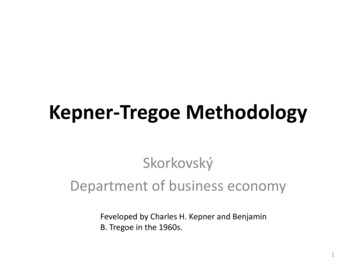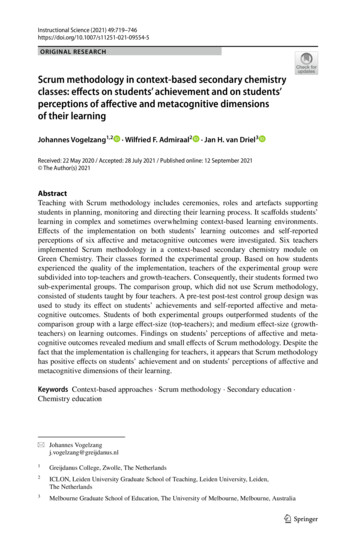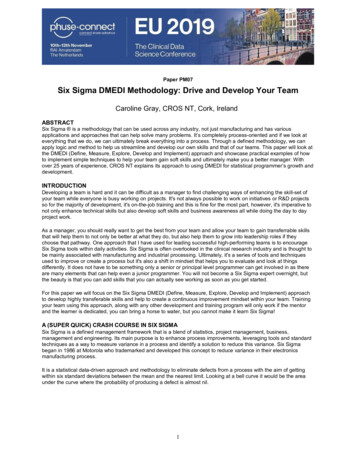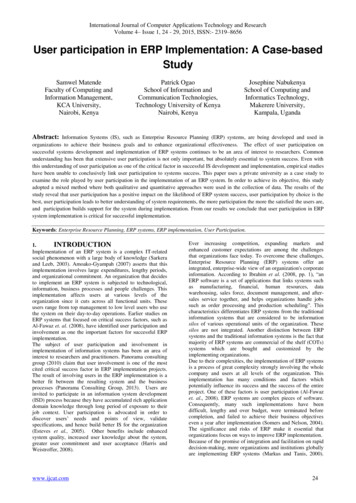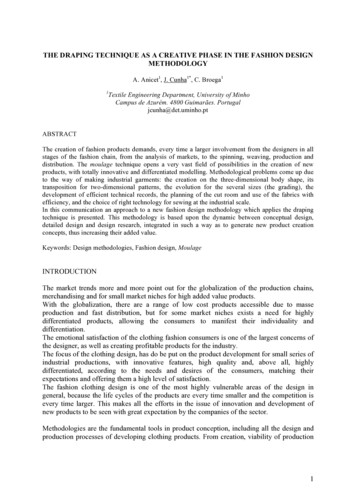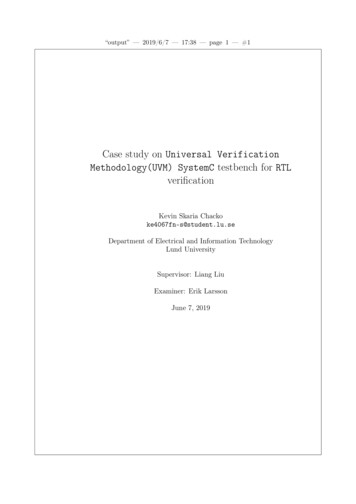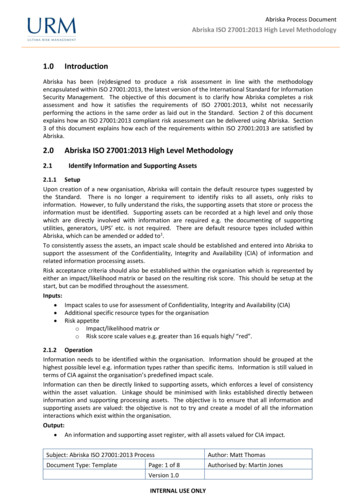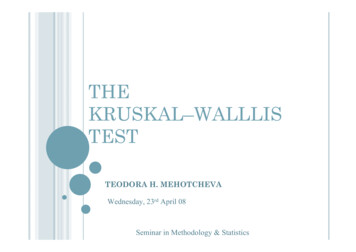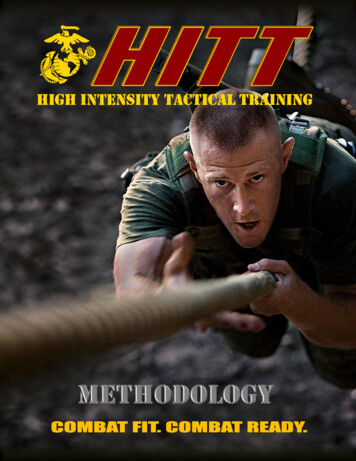
Transcription
METHODOLOGYIntroductionThe High Intensity Tactical Training(HITT) program is a comprehensivecombat-specific strength andconditioning program that is essentialto a Marine’s physical development,combat readiness and resiliency.Different components of performanceenhancement training are keycomponents to superior speed, power,strength endurance and overall combatreadiness while reducing the likelihoodof injury and ensuring that our Marinesare physically prepared for real-timecombat / tactical situations while intheatre.By implementing the latest cutting edge training methods and fundamental scientificprinciples, the HITT program focuses on enhancing athleticism for the today’s tacticalathlete – The United States Marine.To fully understand the methodology behind the HITT program, defining the term“functional” based training as it relates to the tactical athlete is important to understand.Functional based training is a correctly designed program where the repetitive performanceof movement patterns improves an individual's performance of job specific tasks and willbalance physical capacities such as strength, power, speed, agility and endurance whilereducing the likelihood of injuries and overtraining syndromes.Applied correctly, the benefits will be twofold: An improvement in job specific combat tasks, combat readiness and overallphysical performanceReduced injury rates, which can lead to an increased operational longevity of thetactical athlete1
Principles of the hitt programA comprehensive program needs to focus on appropriate strength, power, elasticity, agility,and speed. The HITT Program is based on 3 principles of a sound strength and conditioningprogram:1. Prevent potential for injuryA well designed, balanced, and progressive program will prevent and minimizemuscle imbalances, strengthen tendons and ligaments, along with increasing workcapacity.2. Increase performance levels that support combat specific tasksA sound strength and conditioning program is designed around a comprehensiveapproach balancing all facets of performance enhancement, and exercises that willtransfer to the demands of combat.3. Build strength, optimize mobility and increase speedA stronger, mobile and faster Marine can deliver more force on demand.Components of the hitT programThere are 5 unified components of functional based training within the HITT program:1.2.3.4.5.Movement prepStrength and PowerSpeed, Agility and EnduranceFlexibility and Core StabilityRecovery and mobilityAdditional components include the following:1. HITT performance assessment2. “fueled to fight” nutrition guidance2
Movement prepBenefits of an Active Dynamic Warm-UpThe warm-up is the first component to any sound program. Based on scientific research, thewarm-up is designed to increase body temperature, increase blood flow to working muscles,activate muscle groups, stimulate the nervous system, and increase joint mobility.Performing the warm-up correctly prepares the athlete for success while decreasing thepotential for injury when moving to the next component of the training session.thermoregulationThe physiological responses elicited by warm-up activity not only prepare the body formovement, but also carry out significant functions in enhancing the athletic performance tofollow. One response to warm-up is the elevation of core body temperature. This rise intemperature should be exhibited by a mild perspiration. Elevated core body temperaturelowers the tissue viscosity of the muscles, tendons, and ligaments. A lower viscosity, orresistance, in these particular tissues facilitates an increased range of motion. From aperformance aspect, an increased range of motion in the muscles, tendons, and ligamentsallows for improvements in movement mechanics as well as force production. In addition tocore body temperature, the temperature of working muscles also increases as a response towarm-up. Compared to muscles at homeostatic temperatures, a warm muscle contractswith more force and relaxes in a shorter amount of time. The ability of muscles to contractmore forcefully and relax more quicklyenhances both strength and speed duringtraining. Another goal of warm-up is toincrease oxygen delivery to working musclesvia increased blood flow. The two primarymetabolic and chemical mechanisms thatincrease blood flow to the muscles are anincrease in heart rate and vasodilatation. Uponthe onset of warm-up activity, the heartreceives signals from the nervous systemstimulating a faster and more forceful pumpingaction. This mechanism is complemented by adilation of blood vessels. When muscles beginto work, they emit metabolic byproducts at the cellular level. These byproducts then reactwith the capillaries in the muscle and cause an expansion or dilation. With more bloodflowing to working muscles there is more oxygen available to those muscles. This increasein blood flow and oxygen availability to muscles through warm-up enhances performance byincreasing aerobic energy production for prolonged activity.Injury PreventionWhile there are various intrinsic and extrinsic factors that contribute to sport related injury,a proper active dynamic warm up considerably reduces the chance of injury. As previouslymentioned, warm-up activity can lower the viscosity of muscles, tendons, and ligamentsresulting in an increased range of motion. This mechanism also plays a significant role in3
injury prevention. As the viscosity is lowered and the range of motion increased, athletesalso experience a decrease in muscle and joint stiffness. This creates an internalenvironment that assists in reducing the likelihood of non-contact injuries caused by thestresses of sudden and unexpected movements.Active Dynamic Warm-Up ComponentsThe Active Dynamic Warm-Up consists of multi-joint, multi-muscle movements that arefunctional, similar to mission specific movements, and extend the dynamic range of motionof joints. Beyond the physiological responses, the dynamic warm-up also prepares flexibilitynecessary to perform combat skills, requires balance and coordination, and increasesconcentration levels. Furthermore, the dynamic warm-up addresses the differences ofmovement expressions seen when comparing dynamic versus static ranges of motion. TheActive Dynamic Warm-Up in the HITT program shall employ activities from four categoriesdesigned to encompass the goals and purpose of a pre-activity warm up while emphasizingmovement preparation. The four categories are:General MobilityGeneral mobility exercises are utilized to increase blood flow, take joints through ranges ofmotion, and prepare the body for movement generally executed at a low exertion level inthe start of the active dynamic warm-up.Muscle ActivationMuscle activation exercises are isolatedmovements used to stimulate specific muscles.The targeted muscles are those important toposture, stability, and force application duringspeed and agility training. Generally performedafter core body temperature is elevated, thesemovements are also interspersed throughout theTransit and Dynamic Mobility movements.Transit MobilityTransit mobility is an activity that takes jointsthrough a specific range of motion while travelingover a prescribed distance. These movements aredesigned to reinforce athletic movement, increasedynamic flexibility, while also increasing theintensity of physical exertion.Dynamic MobilityDynamic mobility is an activity that takes joints through an explosive or rapid range ofmotion. While similar to Transit Mobility, activities in this category generally do not travelover a distance and offer a final increase in intensity of physical exertion prior to the skillphase of the workout.4
Active Dynamic Warm-Up Tempo and designA proper warm-up utilizes movements that progress from simple to complex. As a warm-upbecomes more physically and mentally demanding, the muscular and neuromuscularsystems are provided the opportunity to gradually reach training intensity without underworking or over-fatiguing the warrior-athlete. When a warm-up contains challenging andnovel movements, the neuromuscular system is activated and progressively reaches a peakarousal level at the onset of training or competition. As arousal and neuromuscular levelsare heightened, responsiveness is improved and reaction time is decreased. Athleticdevelopment is further enhanced by warm-up when the movements being utilized duplicateor are similar to those learned or practiced in upcoming training sessions. In this scenario,valuable motor skills are rehearsed while serving as a warm-up. Utilizing functionalmovements to elicit physiological mechanisms increases the rate of skill acquisition andaccelerates the evolution of the Marine’s movement training.5
Strength and PowerA properly periodized strength and power training program is the most effective approachto strength training for a Marine. Not only will it help in the prevention of over training, itgives the Marine the best chance of peaking physically at the right time .deployment.Exercise SelectionThe principle of specificity states thattraining should mirror the demands of thecombat specific movements as closely aspossible. This applies not only to the way thebody's energy systems and neuromuscularsystem is taxed (through manipulation ofintensity and rest intervals, etc) but also tothe movement patterns of each exercise.Foundational movementsThe goal of incorporating foundationalmovements into the HITT Program is to emphasize functional movements that will transferthe fitness gained from exercise into improved durability and performance for the tacticalathlete. Foundational movement techniques engage the body as a single coordinatedsystem, complement the movements the body performs on the job and in life, and help tobuild optimal and usable strength, power, mobility and durability. Movement patternsfundamental to most activities can be re-created, loaded, unloaded and trained throughrepetition on the multiple modalities to enhance execution in daily routines. Before addingexternal load it is important to be "bodyweight competent," having the ability to move inthree-dimensional space with accuracy and awareness.1. pushA strong, active plank is the foundation for pushing and pressing movements. Traditionalpushing and pressing exercises are used to focus on chest, shoulder and arm strength.These muscles work together as a group to "push." The push requires you to stabilize yourshoulder girdle to reduce the risk of injury and improve control, strength and power.Pushing exercises integrate core and lower body for improved functional fitness.2. plankA strong core is the centerpiece of efficient and powerful movements. Core strengthdeveloped with traditional crunches, sit-ups and rotational exercises is different than thefocus of the plank, which is bracing the core for stability, keeping the spine stable andresisting motion.6
3. pullPulling movements integrate the entire posterior chain: Shoulders, back, hips and legs.These movements help to develop strength for lifting, pushing, climbing, posture andpulling.4. rotatePracticing and becoming skilled at rotation will improve performance and durability inmovements such as chopping, striking and swinging. Efficient rotation requires a balanceof stability in the hips and pelvis (plank) and mobility in the hips and thoracic spine. Theability to differentiate stability from mobility is critical to rotation. Advanced rotationalmovements often involve pivoting on one or both feet to help maintain joint alignment,improve balance and enhance power. Pivoting is the act of unloading the heels on eitherone or both feet and allowing them to rotate toward the direction of force during arotational movement pattern.5. hingePracticing and becoming skilled at thehip hinge will improve performanceand durability in lower-body exercisessuch as the squat, lunge, steppingand climbing variations. A good hingeincorporates an active plank withdepression and retraction of theshoulder girdle, generating movementfrom the hips. The hinge is thecombination of a stable, supportedspine, controlled flexion andextension of the hips. Examples of ahip hinge include a deadlift, squat,kettlebell swing and pike.6. squatThe squat has been called the king of all lower-body strength exercises because of itsability to develop quads, glutes, hamstrings and the core. Strength should be built upon afoundation of mobility.7. lungeThe lunge is a functional, lower body strength exercise ideally tasked for running, rucking,climbing and other daily activities. The movement works the legs, hips and coremusculature, developing single-leg strength, mobility, balance and coordination. Focusingon the lunge as a foundational movement will carry over to gait, stepping, climbing andcarrying loads. Focus should be on activating the posterior chain (hamstrings, glutes)during the lunge rather than the anterior chain (quads). Focus should also be on extensionof the hip while keeping the foot firmly grounded, taking stress off of the knee.7
Overview of training modalitiessuspension trainingSuspension Training refers to a collection of unique bodyweight exercise movements.These movements are distinguished from traditional exercises in that either the tacticalathletes’ hands or feet are generally supported by a single anchor point while the oppositeend of the body is in contact with the ground. During suspension training, the desiredpercentage of bodyweight is loaded onto the targeted muscle groups, providing the idealmix of instability to train strength,endurance, balance, coordination, flexibility,power and core stability across a widerange of intensities.kettlebell trainingKettlebells develop grip strength and alsoinherently provides an offset center ofgravity. This forces greater whole-bodyengagement that facilitates properexecution of pressing movements.Kettlebell training can be beneficial fordeveloping strength, endurance and power.medicine
The High Intensity Tactical Training (HITT) program is a comprehensive combat-specific strength and conditioning program that is essential to a Marine’s physical development, combat readiness and resiliency. Different components of performance enhancement training are key components to superior speed, power, strength endurance and overall combat
